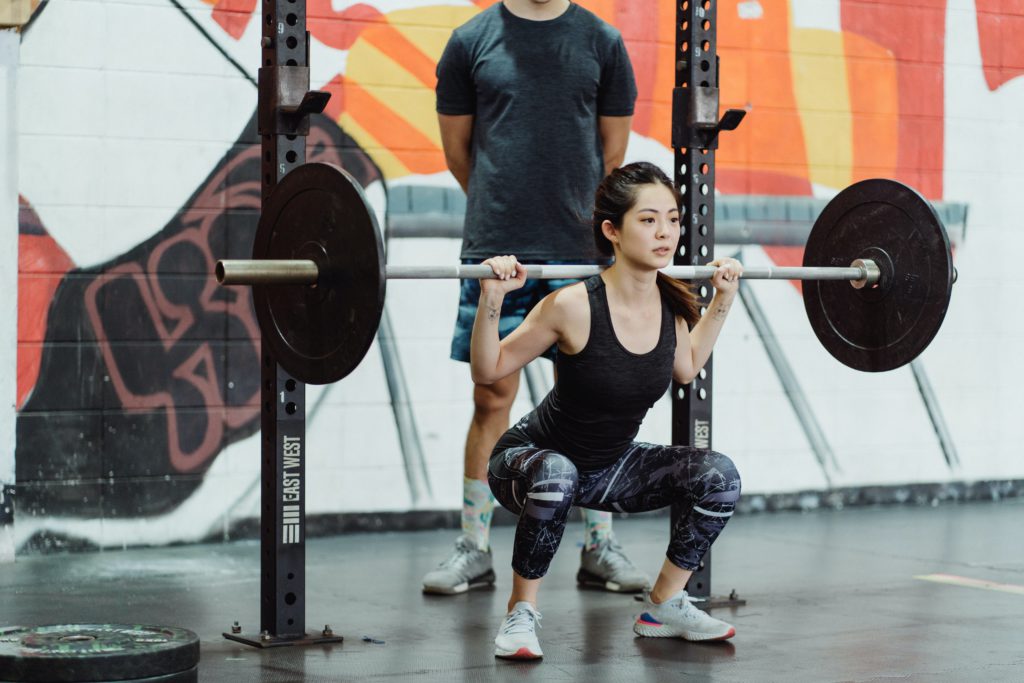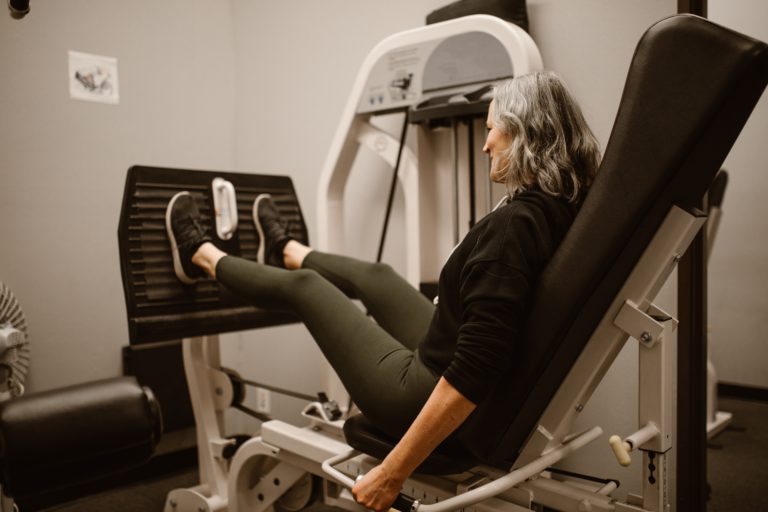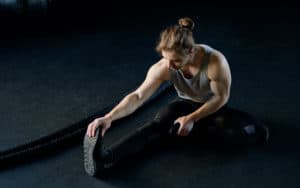
INTRO
What are Squats?

Squats are an exercise that involve lowering and raising your body by bending and straightening your legs, like going from a seated position to standing. This exercise is typically done while holding a barbell or dumbbells across your shoulders but it can be performed using bodyweight alone.
Squats are a compound exercise, meaning they work multiple muscle groups at the same time, including the quadriceps, glutes, and hamstrings. Squats are often included in strength training and muscle-building workouts, as they can help increase muscle size, strength, and power.
Starting a squat challenge with a friend is a great way to create a squat routine and support each other’s health.
Benefits of Squats
Squats are primarily used to improve strength in the legs and glutes, but they can also improve flexibility and mobility in the lower body and help to prevent injuries. Squats can be performed anywhere without weights, and offer a number of health benefits, including:
It’s important to note that the benefits of squats may vary depending on factors such as age, fitness level, and overall health. It’s always a good idea to consult with a healthcare professional before starting a new exercise program.
How to Squat Properly

Like any exercise, squats must be performed correctly to avoid unnecessary injury and strain and get the most benefit from the exercise. Here are some of the most important elements to consider when practicing squats:
Proper form. Proper form is crucial for getting the most benefit from squats and avoiding injury. Make sure to keep your feet shoulder-width apart, your chest up, and your back straight with core muscles engaged as you lower and raise your body.
Gradual progression. It’s important to gradually increase the difficulty of your squats as you get stronger. This can be done by increasing the weight you’re lifting, the number of reps you’re doing, or the length of your sets.
Variety. Mixing up your squat routine can help prevent boredom and keep your workouts interesting. Try incorporating different variations of squats, such as bodyweight squats, kettlebell squats, or barbell squats, into your routine.
Warm-up. Make sure to warm up properly before doing squats to help prevent injury. This can include dynamic stretches and light cardio to get your muscles and joints warmed up.
Cool-down. It’s important to cool down after your squats by stretching your muscles and taking some time to recover. This can help reduce muscle soreness and improve your overall recovery.
Consistency. Building strength and proficiency with squats takes time and consistent practice. Make sure to practice regularly in your squat challenge and be patient – progress is not always linear.

Types of Squats
There are many different variations of squats that can target different muscles, like your hamstrings, quads, or glutes. It’s important to choose the right type of squat for your fitness level and goals, and to use proper form to avoid injury and get the most benefit from the exercise.
Here are a few popular squat variations:
Basic squats
Bodyweight squats that are great for beginners because they involve using your own body weight as resistance as you lower and raise your body.
Box squats
Box squats involve sitting back onto a box or bench as you squat, and then standing back up. These are a great start for beginners.
Sumo squats
Sumo squats are a type of squat that involve taking a wide stance with toes pointing outward, emphasizing the use of the inner thigh muscles, and typically performed with a barbell or dumbbell held in front of the body.
Split squats
Split squats involve standing with one leg forward and one leg back, and lowering your body down as if you were doing a lunge.
Sissy squats
Sissy squats are a narrow squat that isolate the quads, with heels elevated by a heel wedge or other prop. Stand with your feet hip distance apart, lower the body while keeping the knees stationary, and return to the starting position through the contraction of the quads.
Pause squats
Pause squats are a variation of squats where the lifter pauses for a few seconds in the bottom position of the squat, increasing time under tension and helping to improve strength and technique.
Hindu squats
Hindu squats are a type of bodyweight exercise that involves continuous, rapid squats with a bouncing motion and an emphasis on deep knee bends. They’re also paired with an arm swing, starting with your arms in front of you while standing, and with an inhale your arms are brought towards your chest and down to your sides as you squat, and then back up with standing.
Kettlebell squats
Kettlebell squats involve holding kettlebell in front of your chest as you squat. This variation can also be performed with a dumbbell.
Over head squats
Overhead squats involve holding a barbell or dumbbells overhead as you squat.
Barbell squats
Barbell squats involve holding a barbell across your shoulders (for a back squat) or across your chest (for a front squat) as you squat. Form is very important, so we recommend seeking guidance from a coach before starting these on your own.
Pistol squats
Pistol squats involve standing on one leg and squatting down as low as you can, using the other leg to balance.
Pulse squats
Pulse squats are a variation of squats that involve holding a squatting position and then pulsing or bouncing up and down in a small range of motion to target and strengthen specific muscles.
Pop squats
Pop squats are a type of plyometric exercise that involve jumping from a squatting position to a standing position and then quickly back into a squat.
How to Start a Squat Challenge
1
Set a goal
Determine how many squats you want to be able to do and work towards that goal.
2
Make a plan
Decide on a schedule for practicing squats and stick to it. You could aim to practice a few days a week, or even every day.
3
Track your progress
Keep a record of how many squats you can do and how you feel after each workout. This will help you see your progress and stay motivated.
4
Squat with friends
Invite friends, family or coworkers to join your squat challenge and keep each other accountable and motivated to stick to your squat routine.
5
Mix it up
Don’t be afraid to try different variations of squats, such as bodyweight squats, Hindu squats, or sissy squats, to keep your workouts interesting and challenging.
6
Be consistent
The key to building any habit is consistency. Make sure to practice regularly and be patient – it can take time to see progress.
7
Get support
If you’re struggling to stay motivated or make progress, consider working with a personal trainer or joining a group fitness class that focuses on squats. Having someone to support and guide you can make a big difference.
Squatting Setbacks

To overcome setbacks in your squat challenge, it’s important to assess your form and technique, identify any muscle imbalances or weaknesses that may be contributing to the setback. Here are some tips to help you overcome common setbacks when practicing squats.

Incorporate other lower body exercises. In addition to squats, try incorporating other lower body exercises into your routine to build strength and support your squat practice. Examples include lunges, leg press, and calf raises.
Take a rest day when needed. It’s important to listen to your body and take breaks when needed to prevent burnout or injury. If you’re feeling sore or fatigued, it’s okay to take a rest day and come back to your squats when you’re feeling rested and recovered.
Seek support. If you’re struggling to stay motivated or make progress, consider working with a personal trainer or joining a group fitness class that focuses on squats. Having someone to support and guide proper form can make a huge difference.
Use proper form. Make sure you’re using proper form when doing squats to avoid injury and get the most benefit from the exercise. If you’re not sure about your form, consider working with a personal trainer or checking out online resources for guidance.
Gradually increase the difficulty. If you’re struggling to complete a certain number of reps or sets, try gradually increasing the difficulty of your squats by adding weight, doing more reps, or increasing the length of your sets.
Level-Up Your Squat Challenge
There are several resources that can help to support and enhance your squatting challenge, including:
Personal trainers. Working with a personal trainer can provide personalized guidance and support to help you build your squatting practice.
Group fitness classes. Joining a group fitness class that focuses on squats can provide a supportive and motivating environment to help you stay on track with your practice.
Workout buddies. Having a workout buddy to practice with can help you stay accountable and motivated to stick to your squatting practice routine. Consider inviting friends, family members or co-workers to join your squat challenge!
Online resources. There are many online resources available, like the MasterHealth challenges, that can provide guidance and support for building a squatting practice.
Exercise equipment. Using exercise equipment, such as a squat rack or weights, can help you progressively increase the difficulty of your squats as you get stronger.
Apps and tracking tools. There are many fitness and accountability apps, like MasterHealth which also includes tracking tools that can help you track your progress and stay motivated as you build your squatting practice.
Squat Equipment
There are several products that can be used to enhance and diversify your squat challenge. Some examples include:
Squat racks are a type of squat equipment that allows you to safely perform squats with a barbell. They typically consist of a frame with adjustable safety bars to catch the barbell if you can’t complete a rep.
Leg press machine is a piece of equipment (in the image below) that allows you to perform a resistance-based exercise by pushing a weighted platform away from the body using the legs while seated or lying down, targeting the muscles of the lower body, primarily the quads, hamstrings, and glutes.
Weights, such as barbells, dumbbells, and kettlebells, can be used to add resistance to your squats and help you build strength.
Resistance bands can be used to provide additional resistance and challenge your muscles during squats.
Weightlifting shoes are a type of footwear specifically designed for weightlifting activities, including squats. They typically have a flat, stable sole and a raised heel to help improve your form and stability.
Squat pads are a type of foam pad that can be placed on the barbell to provide cushioning and protect your neck and shoulders from the barbell during squats.
Specialized apparel, such as weightlifting belts, knee sleeves, and lifting straps, can help support and protect your body during squats.

Squat FAQ’s
Squats are a highly effective compound exercise that works multiple muscle groups simultaneously. The primary muscles worked during squats include:
Quadriceps – The quadriceps muscles are located on the front of the thighs and are responsible for extending the knee joint (like when you straighten your leg). Squats work all four muscles in the quadriceps group (vastus lateralis, vastus intermedius, vastus medialis, and rectus femoris).
Glutes – The gluteus maximus, medius, and minimus are the muscles of the buttocks that help extend the hip joint. Squats are one of the best exercises for developing strong, powerful glutes.
Hamstrings – The hamstrings are located on the back of the thigh and are responsible for flexing, or bending, the knee joint. Squats work the hamstrings as they help to stabilize the knee joint during the movement.
Calves – The gastrocnemius and soleus muscles of the calves help to stabilize the ankle joint during the squat movement.
Core muscles – The squat is a full-body exercise that requires significant core stability to maintain good form and balance throughout the movement. The core muscles, including the rectus abdominis, obliques, and erector spinae, are engaged during squats and help to prevent back injury during the exercise.
The number of squats you should do per day depends on your fitness level, goals, and any existing health conditions you may have. Here are some general guidelines to consider:
- If you are new to squats, start with a lower number of reps (e.g. 10-15) and gradually increase over time as you build strength and endurance.
- To build muscle mass, aim to do 3-4 sets of 8-12 reps per day, with a weight that challenges you.
- To improve endurance and cardiovascular fitness, aim to do higher reps (e.g. 15-20) for several sets per day.
- If you have a health condition or injury, it’s important to speak with your doctor or a certified fitness professional to determine the appropriate number of squats for you.
Ultimately, the key to seeing progress with squats (and any exercise) is consistency, proper form, and gradual progression. It’s also important to listen to your body and take rest days as needed to allow for recovery.
The number of calories burned during squats can vary depending on various factors such as body weight, age, intensity, duration, and form.
On average, a person who weighs 150 pounds (68 kg) can burn approximately 135-200 calories in 30 minutes of moderate-intensity squats, while a person who weighs 200 pounds (91 kg) can burn around 180-270 calories in the same amount of time.
However, it’s important to note that squats alone cannot result in significant weight loss, and calorie burn from exercise should always be combined with a healthy diet and lifestyle for effective weight management.










